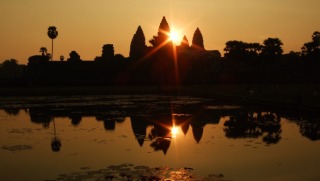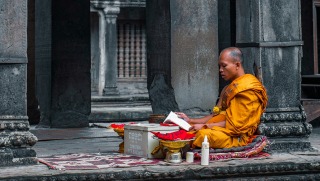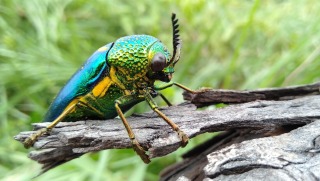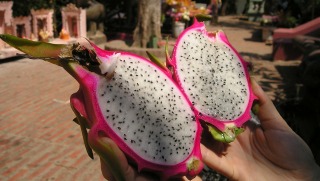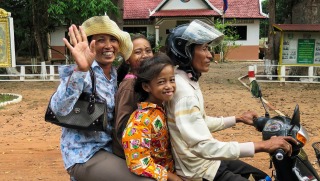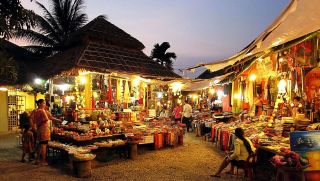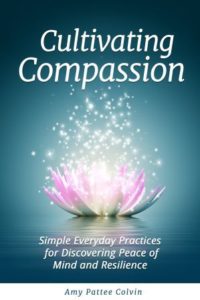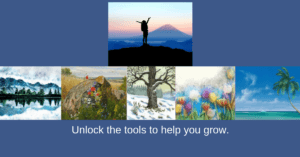A meditation retreat to Cambodia offers a diverse array of gems for open-hearted, curious travelers looking for a spiritual adventure.
Landscapes range from breathtaking beaches to magnificent forests. Spiritual history encompasses Hindu, Buddhist, Islamic, and animist traditions. Awe-inspiring temples seem to sprout from the earth.
Take your time and explore Cambodia’s rich spiritual history; eat flavorful food, and converse with smiling locals.
Travelers often come to Cambodia primarily to visit the Angkor temples, but many find their most vibrant memories are of the landscapes, culture, and people.
1. Steep in the Spiritual Energy of Angkor Wat
Cambodia is home to Angkor, a UNESCO World Heritage site, the largest religious monument in the world. Its name translates to “the city of temples,” and Angkor served as the capital of the Khmer empire from the 9th to 15th centuries.
With their intricate carvings, statues, and seemingly delicate towers, the temples of Angkor Wat Archeological Park offer a beautiful testimony of the grandeur of Khmer architecture.
Angkor Wat was initially dedicated to Vishnu, the Hindu god who preserves the world from evil entities. Over time the temples gradually became places of Buddhist worship. No matter your faith, connect with your inner wisdom as you wander in and out of ruins. Breathe in the rich aromas floating on the thick jungle air, and allow your spirit to be transported into the past.
The Angkor Wat Archeological Park is immense and encompasses many unique, beautiful, and diverse ruins. The below list highlights only a few of the main temples.
- Angkor Wat, the largest and best-preserved Hindu temple, consists of three rectangular galleries and five lotus-bud shaped towers. You’ll find large-scale carvings depicting scenes from the Hindu epics, the Ramayana and the Mahabharata, on the inner walls of the outer gallery.
- Bayon, the central temple of the ancient city of Angkor Thom, hosts 216 massive stone heads whose benevolent faces gaze down at temple-goers from every direction. The prevailing theory is that these faces represent Avalokitesvara, otherwise known as Kwan Yin, the bodhisattva of compassion.
- Ta Prohm, a Buddhist temple that once housed 12,500 people, reflects the binding energy and power of the jungle as trees erupt out of the ruins and roots cling to ancient structures.
- Banteay Srei, dedicated to Shiva and considered to be the art gallery of Angkor, is a small temple whose walls erupt with decorative carvings of divine figures and elaborate floral motifs. Though this temple is a 30-minute drive north of the main complex, a visit is well worth your time.
Visit Angkor at a relaxed pace, and if possible, witness sunrise and sunset within view of one or more of the temples. Take a moment to meditate on the beauty and energy around you. During your meditation retreat to Cambodia, a visit to Angkor will help you create memories you’ll carry with you forever.
2. Relax on a Remote Island Beach
Often masses of tourists flock to the beautiful beaches of neighboring Thailand, which leaves the gorgeous Cambodian alternatives sparsely populated.
This lack of commercial tourism helps these island beaches maintain unspoiled authenticity as they remain off the tourist radar.
These uncrowded beaches provide a perfect place to breathe deeply, cultivate your meditation practice, and relax while on a spiritual tour.
Koh Rong offers powder white sandy shores at the edge of a turquoise sea. In 2017 National Geographic listed Lazy Beach on Koh Rong as one of the 21 best beaches in the world.
Imagine waking up with a morning meditation, going for a swim, practicing mid-day qigong, snorkeling a coral reef in the afternoon, then ending the day with a sunset meditation. Time in between is spent relaxing and having heart-opening conversations about acceptance, compassion, and joy with like-minded fellow travelers.
3. Watch for Wildlife in Magnificient Jungles
One of Southeast Asia’s most species-rich and intact natural habitats is found in western Cambodia’s Cardamom Mountains, which are bordered by Cambodia’s largest National Park, Botum Sakor.
Harmonize with the subtle energies around you as you trek with a forest ranger through the vibrant woodlands or sweeping grasslands in one of the region’s most significant preserved landscapes.
A visit to Botum Sakor National Park offers an opportunity to witness unique biodiversity, which includes over 45 species of mammals like the pileated gibbon, Bengal slow loris, the Sunda pangolin, and Indochinese tiger.
This region also hosts a diversity of avian life, including a few rare species. This region, once covered by evergreen forests and woodlands, is now protected and consists mostly of mangroves and grasslands.
A multi-night stay in Botum Sakor during your meditation retreat to Cambodia helps you to recognize the deep connection between your personal energy, and that of flora and fauna around you.
A gentle paddle in a kayak on the river or a leisurely walk in the local forest helps you recognize and revel in the harmony and flow between people and landscape.
4. Savor Unique and Flavorful Food
Most Khmer food is nurturing and simple. Rice is a staple served at nearly every meal.
However, due to Cambodia’s proximity to Thailand and Vietnam, it is natural that the country’s cuisine shares certain traits with its neighbors. Generally, Cambodian food contains less sugar and coconut milk than its Thai counterpart, and chili is often served on the side rather than mixed into the dish.
You’ll still find lemongrass, limes, shallots, and bananas adding flavor, as well as the influences of herbs more than spices.
The most famous Khmer dish is fish amok—curried white fish steamed in a banana leaf and topped with coconut cream.
Other typical dishes include bok svay—green mango salad served with dried fish—and samlor kakou—soup made with green banana, papaya, and vegetables.
Chicken and pork are commonly served with noodles or rice and often with herbs or curry. If you’re feeling adventurous, you can sample popular snacks such as deep-fried grubs and crickets.
What you won’t find is McDonald’s. Cambodia is one of the few countries in the world where this food chain has never opened its doors. In rare cases, you’ll find a Burger King or KFC.
However, with little effort, you’ll find delicious and nutritious food made by locals everywhere you look. A great way to experience authentic food is to book dinner at one of Siem Reap’s NGO-funded training restaurants, which offer hospitality training to young Cambodian’s, helping them gain valuable work skills and future employment opportunities.
5. Chat With Friendly Locals
Mingle with the locals when possible. During your stay in Cambodia, you’ll notice the kindness and warm smiles of the Khmer people.
Though Cambodia is an economically developing country, its citizens are kind and hard-working, hospitable, generous, and open-minded.
In most places, you’ll find locals eager to show you their country’s treasures and tell you their stories.
You’ll find the gentle nature of Khmers in service staff, tuk-tuk drivers, tour guides, and passersby on the street. As you observe the locals, let that sense of gentleness, peace, and kindness infuse you so you can reflect it out to others.
If you have time in Siem Reap, be sure to spend an evening at Phare, the Cambodian circus. This Siem Reap-based performance troupe offers local youth training and employment while helping them maintain Khmer cultural history. Join me for a spiritual tour to Cambodia and we’ll spend an evening enjoying the circus.
6. Explore Vibrant Markets
Another way to interact with warm-hearted Cambodians is through a visit to the market. Bustling markets are found across the country from Phnom Penh to Siem Reap.
The narrow walkways and alleys may feel cramped at first. Bodies are everywhere. But after settling your mind, connecting with your senses, and taking a few calming breaths, you’ll be awed by what is in front of you.
From pungent spices to herbal remedies and from sneakers to typical produce, these markets have all the necessities for Cambodian daily life. An unimaginable array of goods line tables, walls, the ground, and hang overhead.
Visiting a market is offers a visceral way of connecting with Cambodian daily life. Even if you’re not interested in buying anything, wandering the narrow market corridors is an unforgettable experience that provides insight into this vibrant culture.
Now that your interest is piqued join me for a meditation retreat to Cambodia, where you’ll have an opportunity to experience all of the above highlights first hand.
Enjoy a heart-opening spiritual journey to the beautiful natural sites of this rich and varied land, and make real connections with local people.
You’ll return home with an inspiring travel story that captures the diverse and unique essence of spiritual Cambodia.
Explore this website for further information or please contact me with any questions.

